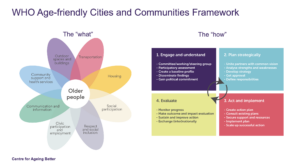Age-friendly communities help us stay healthy and active
Välfärdspolitik
22 nov 2023
By 2040, about 25 per cent of the Nordic population will be aged 65 or older. But we're not ageing evenly everywhere. For over a decade, Natalie Turner has been working with creating more places where people can enjoy later life in both the US and the UK. “This can be done anywhere. Key elements are knowing your city, building relationships and listening to what matters to older people”, she says.
So, what is an age-friendly community? It’s a place that enables you to age well and live well when you are old. Where it is possible for people to continue to stay in their homes, participate in the activities that they value, and contribute to community life, for as long as possible.
– It’s about ageing, not just about being older. That’s important because an age-friendly community should promote the behaviours that help us stay healthy and active for longer, while also reducing barriers to doing the things that matter to us, if or when our abilities decline, says Natalie Turner.
Involve many, but start with the old
Turner was invited as one of the keynote speakers at the conference Age-friendly cities in the Nordic region, arranged by the Nordic Welfare Centre and World Health Organisation (WHO) in Copenhagen 2–3 November. In 2016, Turner joined the UK’s Centre for Ageing Better, where she is now working as Deputy Director for Localities.
To create an age-friendly city or municipality, you will need people from many different sectors and services on board: local politicians, academic institutions, civil society, newspapers and radio, libraries, shops, cafés, gyms, bus companies and parks.
– People in these different sectors and services might not understand why it matters to them, you will need to be able to show why ageing populations and the needs of older people matters, and the importance of planning for the future, says Turner.
Wherever you start, older people should be at the centre of all.
– Your work needs to involve the people affected, their voices are often the most powerful, says Turner.
What is important, and how do we get there?
There are two key elements of creating an age-friendly community: the “whats” and the “hows”. The eight “whats” have been developed by WHO together with older adults and stakeholders across the world. They include, among other things, housing, social participation, employment and transportation.
The “hows” are how you get there. It’s about engaging and understanding, planning strategically, evaluating, acting and implementing.

– Both of these matter. For example it is not just about whether you can physically access the town centre or the community building. It can also be about whether the activities happening inside are welcoming and inclusive, and if you have the information you need to find out about it, says Turner.
Typically the process to become a more age-friendly community is about five years, but it can be less, says Turner. Small steps can make a big difference. On the Isle of Wight, a British island just off the coast of Southampton, bus industry staff received age-friendly training to get an understanding of the frustration and demands of their older customers. By using sight simulation glasses and noise-cancelling earmuffs, the staff were able to experience what it is like to be deaf or blind on the bus.
Understand your city
In the UK, the age-friendly network has 70 members, from city regions like London with over 8 million people to rural counties. To create places where people can live a good later life is possible anywhere – the key is understanding your city or community. Where are people ageing, and how well? Which are the biggest differences between parts of your city, or between your city and the rest of the country?
When Turner worked locally in London, she worked more closely with older adults themselves and got to hear about what mattered to them and what their priorities were.
– Things that came up a lot were basic amenities like transport, toilets and seating; the things needed to get out and about to do everyday things and stay independent, she says.
Age-friendly benefits everybody
Many of the things that age-friendly communities are looking to do can benefit all ages, and all parts of the community. Accessible, age-friendly housing with wider doorways and easier entrances are also good for families that need to get pushchairs in and out, or younger people with disabilities, says Turner.
– Age-friendly employment promotes flexible working, which is also good for people at different stages of their lives. By creating a city or community where people can thrive at every age, we’re looking after our future selves, and ensuring that we can all still benefit from the huge contributions we make to society well into later life.
Text and photo: Heidi Hakala

